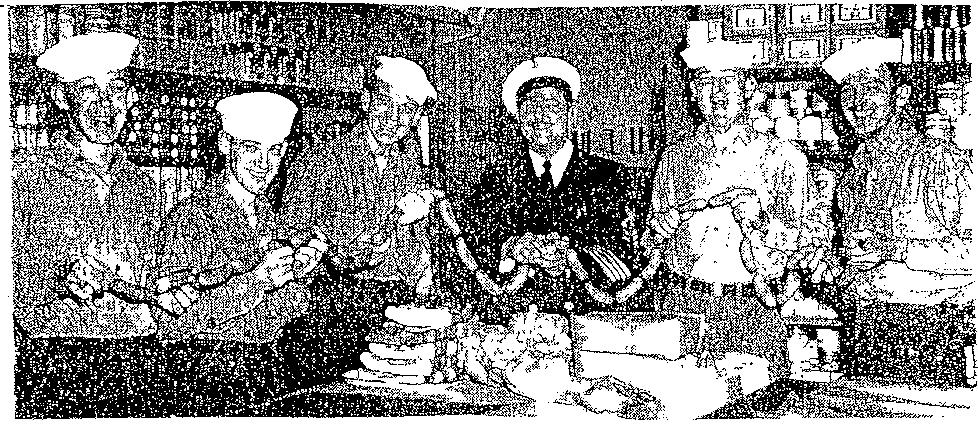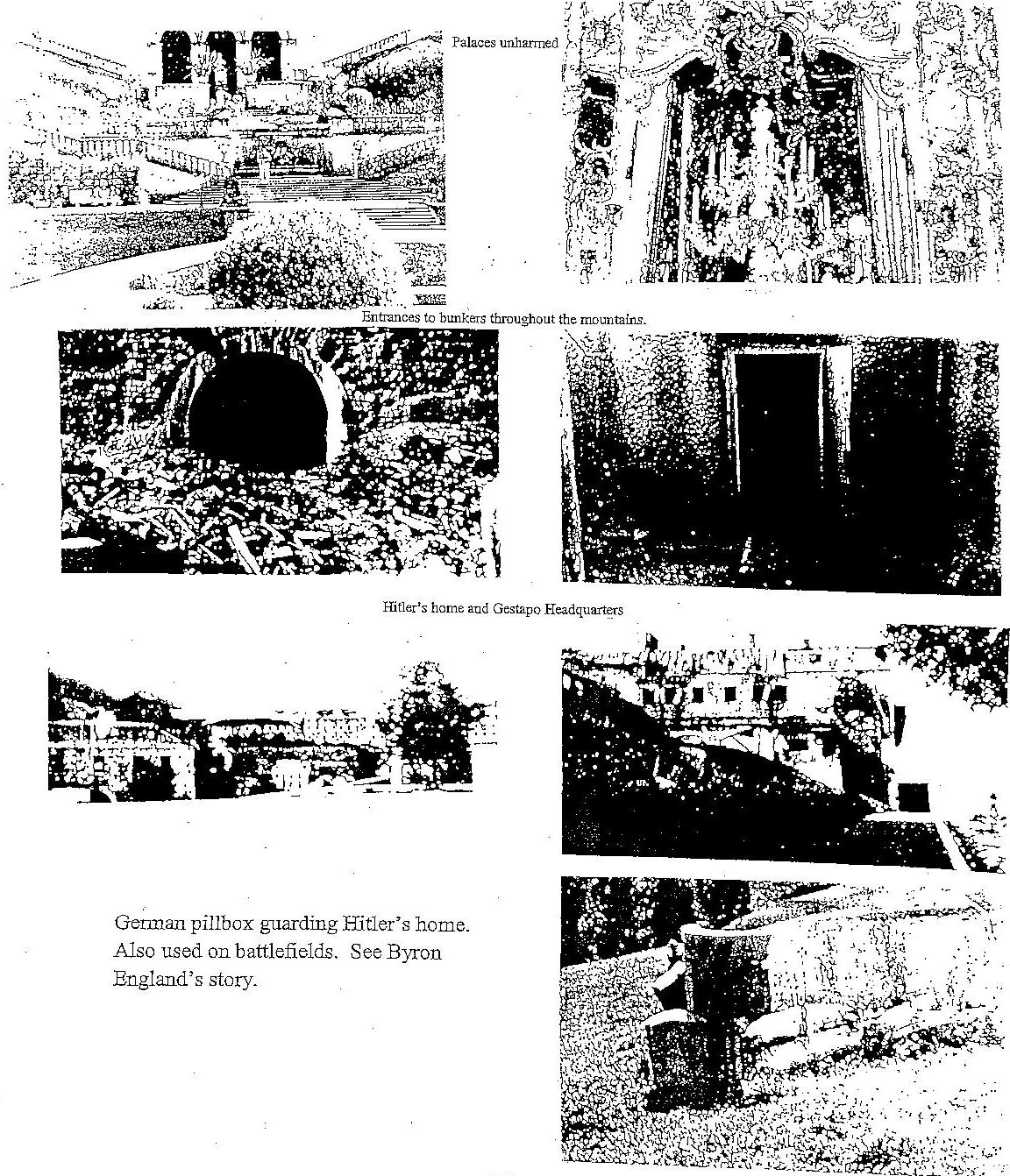ROBERT AND DARLENE POSEKANY
.
Many veterans return with a multitude of memories but one particular event stands out in the course of their service. This is the case with Bob Posekany, who not only has a picture memorializing the experience, but that picture was sent to the States and appeared in every newspaper in the country. It shows the unveiling of a statue of President Franklin Delano Roosevelt, at 20 Grovenor Square in London, and Bob on the steps in front of it.
The following letter was sent to Mr. and Mrs. Charles Posekany from the Fleet Home Town News Center, Ninth Naval District, Building 1.A, Great Lakes, Illinois. "Dear Mr. and Mrs. Posekany: I am pleased to be able to send you the enclosed negative and print for whatever disposition you wish to make of them. The Navy Department has authorized me to forward the enclosures to you with the thought in mind that they would be put to better use in this way than by storing them in the official files. They are sent to you at this late date because official Navy photographs and negatives must be retained on file for a certain period of time. Sincerely yours, (signed) B.F. McDevitt, LCDR (S) USNR Officer-in-Charge.
|
|
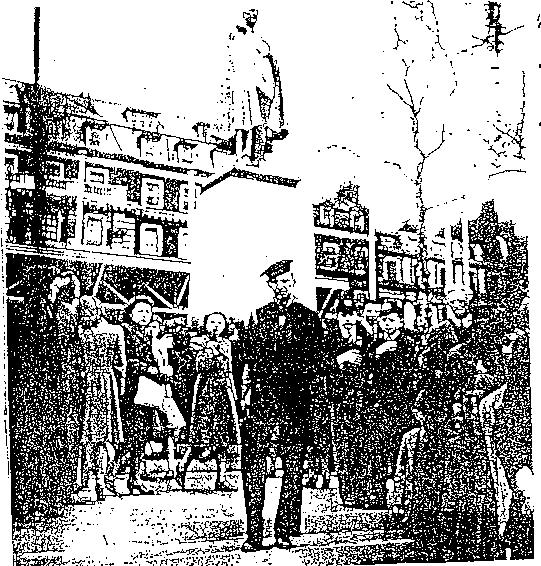
|
|
Although Darlene and Bob weren't married at that time, Darlene's cousin and Bob were in close proximity. The cousin, Ralph Fratzke, worked at 10 Downing Street and was a secretary to the Pottsdam Conference in July and August of 1945, when Truman, Stalin and Churchill "established the political and economic principles governing the treatment of Germany in the initial period of Allied Control at the end of the war. They also sent an ultimatum to Japan demanding unconditional surrender on pain of utter destruction." (From Hutchinson Dictionary of World War II.) He was also at the unveiling of the Roosevelt statue.. Darlene tells- "When we were at Mother's house one day after church, my cousin Ralph told about the two fellows being at the same place at the same time."
Bob
I was born in Aredale, Iowa on March 2, 1929. My father was a railroad man as was his father, who had retired as Roadmaster. My father was a waterboy at the age of 13 when they were putting tracks into the coal mines of Lucas, Iowa. Our family moved many times as Dad worked his way up to Roadmaster on the Chicago Northwestern. We lived in Lake Mills, Mason City, Parkersburg, Dike, Belle Plain and Traer. When I got to eighth grade, I told them I wasn't going to move anymore and went to live with Grandma in Dike, Iowa. That was the place I called home for many years. I tried working with Dad one summer, and knew I didn't want to do that.
I enlisted in the Navy in February 1946, before I graduated from high school. They called it a "minority cruise" if we enlisted when we were 17, and we would be discharged when we were 21. Under that agreement, I served until 1950. My boot training was in the San Diego Naval Training Station, during which time I took sick with rheumatic fever and was in the Corona Naval Hospital in California. It left me with some disabilities.
When I was discharged from the hospital, I went into service duty in the Seabeas, the construction battalion. For that training I was sent to Port Hueneme, California, after which they sent me to the Navy School of Justice in Oxnard, California. I am actually not sure why I was sent there, but the next schooling was in Little Creek, Virginia, for advanced training in the Seabees. From there I was sent to London, England and attached to the Embassy at 20 Grovenor Square.
I have a box of mementos from that time. England was still living in the aftermath of the war with effects of the Blitz that lasted essentially from the first week in September 1940 until November 14 of that year, with occasional raids thereafter. I have pictures of bombed out areas. There were no subways. They didn't return to subway use until 1948, nor did they turn lights on until then. There were, at one time, 17 airfields on the outskirts of London and thousands of bombers. I have a picture of them taking off. The sky is full of them! I was issued a personal identity card and there were ration books for food and clothing.
There were about 150 of us employed at the Embassy, but with a few exceptions, we lived as civilians. We found our own living quarters. After we had been there for about six months five of us fellows got together and rented a house. I first lived in a flat in Newcastle and later moved to Devonshire Place, about a block from where Admiral Connolly lived. The house came with maid, butler and gardener. While we were on duty, we did not wear Navy uniforms but civilian clothes. They gave us, over and above our military pay, $18.75 a day for our living subsidy, and that amount increased each year. (By the time I left it was $30.80.) With it we shopped for food and clothing, and I still have the ration books for each. We did have
commissary stores for buying American food. I was issued my own jeep and still have my English driver's license.
Our work at the embassy was carpentry. With every new commanding officer, we were issued a new jeep, and for every new jeep, I had to build a new body for it — wooden with glass windows. It had to be enclosed for protection from the weather.
Our commanding officer at the Embassy was Admiral Connolly, Commander in Chief of the United States Naval Forces of the Eastern Atlantic and Mediterranean. I built a greenhouse for him. He was outstanding! Congenial and generous. He made his plane available to us for vacations. Every Tuesday morning it would leave from Hinden Field, England and fly to Paris, Munich, perhaps Copenhagen and back to England. If we went on it, we had to be at the designated place to be picked up the next Tuesday. So we had an entire week to enjoy whichever area we chose. The following picture shows us enjoying our food at the Navy Commissary in London:
The caption read: The lowly hot dog helps round out many a rationed meal for Navy Personnel of the London located command of Admiral R.L. Connelly, Commander in Chief of the United States Naval Forces, Eastern Atlantic and Mediterranean. Above, the chain of command is: J.T. Vesolosik; C.E. Mayer; Emile Zupan, M.I. Knopp CSC: J.O. Calfee, and Oscar V. Traweek.
One of my favorite places to go was Germany. We often went to a rest and recreation area on Lake Eibsee. The pictures that follow were taken with a micro-16, which was a camera that would fit inside a cigarette package. We weren't allowed to take pictures but they didn't question if we took out a package of cigarettes, and I had that little bitty camera inside.

The prices were interesting. Drinks were 300, wine $1.50 a bottle or 400 a glass.
We had physical evidence of the precision of our bomber crews. Palaces were untouched, while the area of Berchtesgaden, Hitler's chalet in the Bavarian Alps, was demolished. I have a picture of the entrance, which led to tunnels (bunkers) all through the mountains, but we didn't venture too far. In fact, we took a ball of yarn, walked as far as the yarn would take us and turned back. We visited the area where the Gestapo Headquarters had been. It was blown to pieces, and all that was left looked like a big crater. There were homes around it, but they were not bombed.
I spent a couple weeks every two or three months on vacation in Gennany in the Berchtesgaden area. One place where we went was a very large amusement area with ice skating, a dance floor that rolled over the top of the ice, and a roof that could be rolled off to make it an open air facility.
When we finished our commitment in England we were flown home, and I was
discharged in Norfolk, Virginia in March 1950. I had spent four years in the Navy and was never aboard ship while it was sailing.
I came back to Dike and started my construction business, which became my career. In 1970, mostly due to the influence of George Buesch, I moved my construction company to Osceola. At the time there was only one other construction company here, and others were beginning to bring in double wide homes. I was a general contractor building custom homes. It was at that time, I met Darlene.
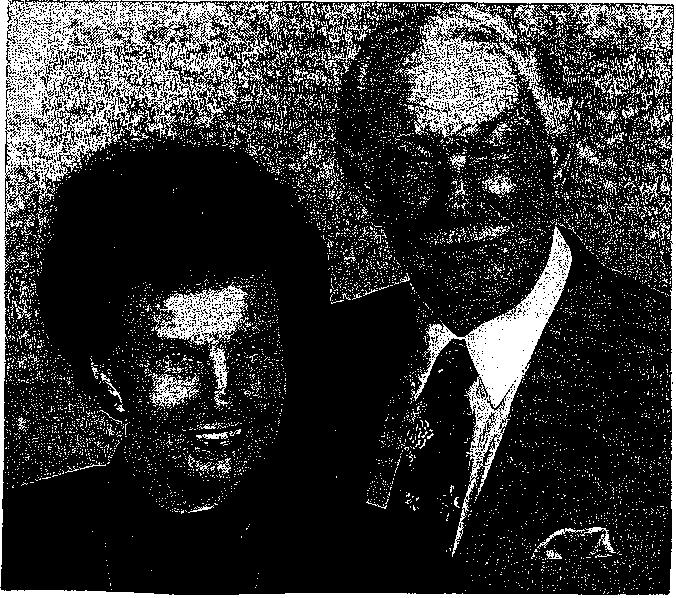
|
|
Darlene
I was born in Bremer County, Iowa, December 29, 1930. I have three brothers and a sister. My father, along with his two brothers, were building contractors in the area. I went to parochial school at Fairbank, Iowa for eight years and graduated from Fairbank High School in 1948. I graduated the following year, 1949, from Americana University of Beauty in Des Moines, and worked at Younkers Beauty Salon.
I moved to Osceola in 1955, to Weldon in 1960, and had beauty shops in both places.
My daughters attended Weldon Grade School and graduated from Clarke Community in 1969 and 1971, respectively. |
|
In 1970, Bob and I were introduced through mutual friends. I appreciated meeting him after living alone for ten years, raising my two daughters by myself. We discovered we had a lot in common — our goals were the same, and we had the same work ethic. I had tried to teach my daughters some of the same principles Bob and I have: it is important to live within your means, to know what you want and how to get it without expecting it to be given to you. A key to success is having goals. It is good to have life goals, but necessary to have small goals in order to achieve the larger goals. They have lived accordingly and have achieved their own goals.
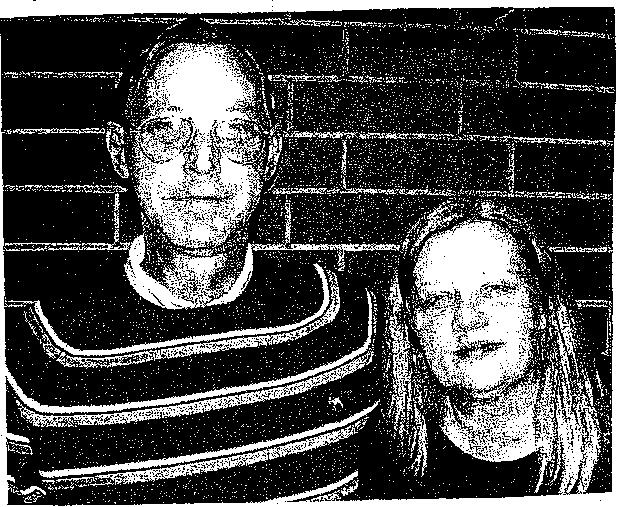
|
|
Bob and I were married June 26, 1971, in Osceola and became one family. Bob's son Charles and family live in Woodburn, Iowa. In 1996, Charles started as a design engineer, designing kiosks for retail and food service, and now works as Project and Quality Control Manager for the Commercial Modular Building program, Merchandising Frontiers of Winterset, Iowa.
Charles' wife, Susan, has worked for Sears for 12 years. She is currently a member of the management team, specializing in design and support of multi-site intranet with the title Intranet Web Designer/System. Analyst.
|
|
Their daughter Anna is finishing her final year at Grandview College with a major in Accounting. She will be working an internship at McGowen Hurst, Clark and Smith during her last semester. Anna participated in the Future Business Leaders of America during high school and recentlyplaced third in "Accounting for Professionals," and sixth in "Accounting Analysts and Decision Making" at the National competition in Chicago for the Future Business Leaders of America, "Phi Beta Lambda."
|
|

|
|

|
|
Daughter Tesia is attending Clarke Community High School as a sophomore. She has already competed at the varsity level and lettered in three sports: basketball, track and field running events, and softball. She was awarded "The Most Improved Player" for the varsity softball team when she was playing as a freshman. She has been and is currently an "A" average student, and looks forward to a sports scholarship to attend college at a major university. |
|
Bob's daughter and husband Rhonda and Pat Eppley live in Shell Rock, Iowa, where Rhonda owns a pet grooming company. Pat is affiliated with the family business of Eppley Seed Company in Shell Rock.
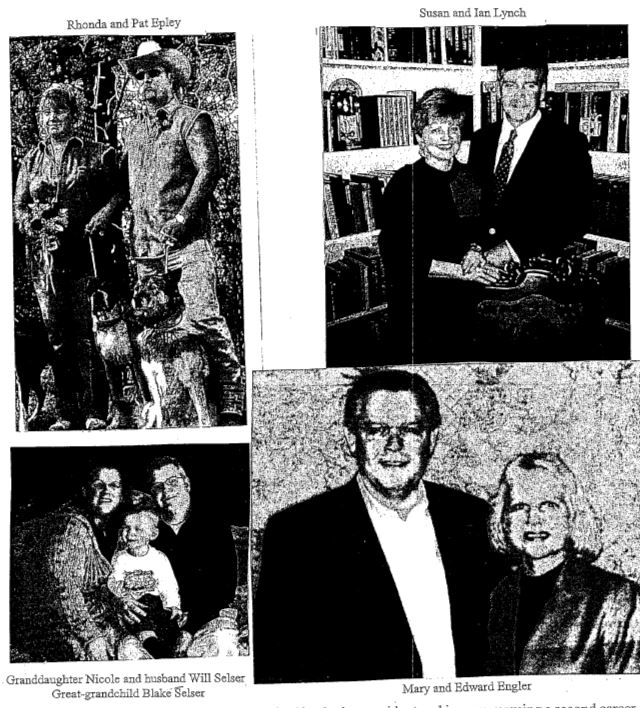
My older daughter, Susan, is a retired bank vice president and is now pursuing a second career as a professional organizer. Her husband, Ian Lynch, is a motion picture cameraman. They have lived in New Orleans since 1984. My daughter Mary and husband Edward Engler live in West Des Moines. Ed is on the Board of Adjustments for the city of West Des Moines and serves as President for the Valley Junction Residential Association. Mary manages their offices and rental properties. Their daughter, Nicole, and her husband, Will Selser, also live in West Des Moines. Sgt. Selser is a career Army man as a heavy wheeled diesel mechanic and was deployed to Iraq in January 2008. Nicole owns and operates two West Des Moines businesses: Engler Embroidery and Walnut Place Retreat. She also serves as Secretary on the Historic Valley Junction Foundation Board of Directors. Nicole and Will have a son, Blake, age 2.
Bob and I have enjoyed our married life. We've done a lot of traveling, going on five cruises — two to the Caribbean, two to the Mexican Riviera, and one to Alaska. We have also traveled to Rome, Spain, Monte Carlo, Hawaii, and Tangiers, Africa to which we took a hydrofoil from Spain. I'm happy that we did our overseas traveling when we were in our forties and early fifties. Now we enjoy cruises and travel within the United States.
We have lived in four homes, and now in our retirement, have designed and built a three-bedroom ranch home to suit that lifestyle. Our living area is all on one floor and the halls are wide. Everywhere we traveled, we picked up mementos and incorporated them into our home. We designed our home with family heirlooms in mind and wanted a house to display them appropriately. The powder room is designed in a Princess Grace theme that is reminiscent of our trip to Monaco. I love color and jewel tones intensify the formality of the nine-foot ceilings that are featured in all of the rooms. Off-white woodwork and heated floors are some of the many unique and interesting features of the home. In 2004, our home was selected to be on the Christmas Tour of Homes.
We don't plan to move again. We love Osceola and its people. We have property in Horseshoe Bend, Arkansas, which is the middle of the United States, halfway between our daughters but we chose to stay here.
In earlier years, beginning in 1950, Bob was involved in stock car racing at the Waterloo Tunis Speedway. He successfully raced on tracks across the state, capturing the checkered flag at the Iowa State Fair stock car race in 1953. He was President of Cedarloo Racing Association from 1953 to 1959, and President of Greater Iowa Racing, Inc. from 1961 to 1965. He was the Registered Official of the IMCA (International Motor Contest Association) from 1968 through 1969. His participation continued until then, when he developed some heart problems. However, he promoted the races at the Bethany, Missouri Fair. He had all the drivers he raced with up north come down for the event. Over 30 responded. |
|

|
|
Now, in 2008, Bob has retired but over the course of years, built 128 houses in Osceola and the surrounding area. Mostly they have been speculative houses which he then sold. He continues to honor his service years, is a lifetime member of American Legion, DAV — Disabled American Veterans, and AmVets, for which he started the post in Cedar Falls, Iowa.
Return to main page for Recipes for Living 2008 by Fern Underwood
Last Revised October 18, 2014

